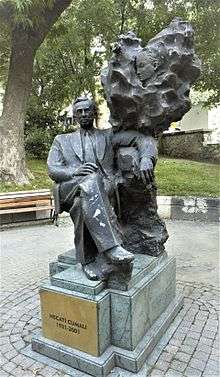Necati Cumalı
Necati Cumalı (13 January 1921 – 10 January 2001) was a Turkish writer of novels, short-stories, essays and poetry. He was born in Florina, Greece to a Turkish family and his family had settled in Urla near İzmir in the framework of the 1923 agreement for the population exchange between Greece and Turkey.
Necati Cumalı | |
|---|---|
 Sculpture of Cumali at Beşiktaş | |
| Born | 13 January 1921 Florina, Greece |
| Died | 10 January 2001 (aged 79) Istanbul, Turkey |
| Education | Ankara University |
| Occupation | Writer, poet |
Biography
He grew up in Urla and did his studies in İzmir and he started his law education at İstanbul University then completed it in the Law School of the University of Ankara. He started writing poetry while he was still a student and his poems were published as of early 1940s in such prominent Turkish literary periodicals as Varlık and Servet-i Fünun. Toward the end of that decade, while he was doing his military service, he also started writing short stories in which the profound influence of another important Turkish writer, Sabahattin Ali, could be felt. This, and the themes of social consciousness obvious in his works could be the reason for which he was sometimes cited in the same title as other "writers of the left", although he never actively engaged in political issues.
His vivid portrayal of women in his works was particularly noted.[1]
Author of about 15 books of poetry, and that many books of short-stories and novels, as well as plays, Necati Cumalı died on 10 January 2001 in Istanbul.
His valuable collection of books was donated to Koç University after his death.[2]
In 2002 a sculpture of Necati Cumali by the sculptor Gürdal Duyar was erected at the Şairler Sofası Parkı, a park in the Vişnezade neighborhood of Beşiktaş, Istanbul.[3][4] [5]
Works
One of his best known works is the short-novel, "Dry Summer" (Susuz Yaz), adapted by the film director Metin Erksan to cinema in 1964, starring Hülya Koçyiğit and Erol Taş, and which won the Golden Bear award in Berlin Film Festival that year.
Another famous novel by Necati Cumalı is "Devastated Hills: Macedonia 1900" (Viran Dağlar: Makedonya 1900), where he relates the history of his own family which descended from a long line of Turkish Beys (Cuma Beyleri, "the Beys of Djuma"), with the turmoil in the Balkans providing the background. This novel has been adapted (not very faithfully) for the television by Michel Favart in 2001 as a multinational ARTE production under the title "Le dernier Seigneur des Balkans".[6]
His poetry was translated into French by Tahsin Saraç. German Translations:Ö Der Mann aus Akhisar, Kitab-Verlag Klagenfurt, 2007 Des Balkans letzter Bey (Viran Daglar), Kitab-Verlag Klagenfurt, 2009
Bibliography
- Sea rose: a play in three acts, Ankara: Ministry of Culture, 1991. ISBN 9789751708939, OCLC 26072810
- Çalıkuşu; oyun 3 bölüm, Reşat Nuri Güntekin'in romanından oyunlaştıran Necati Cumali. İstanbul, İnkılâp ve Aka Kitabevleri, 1963. OCLC 23550881
- Yalnız kadın: hikâyeler, İstanbul: Sander Yayınları, 1976. OCLC 977800156
- Aşk da gezer: roman, İstanbul: Çağdaş Yayınları, 1998. ISBN 9789757720249, OCLC 70234832
- Ay büyürken uyuyamam, İstanbul: Cumhuriyet, 2004. ISBN 9789756747100, OCLC 70276936
References
- "Some Aspects of the Portrayal of Women in Modern Turkish Literature". 6/2. British Society for Middle Eastern Studies. 1979. JSTOR 194319. Cite journal requires
|journal=(help) - "Necati Cumalı collection at Suna Kıraç Library" (PDF). Koç University. May 2008. Archived from the original (PDF) on 6 March 2009.
- Gazetesi, Yeni Mesaj. "Beşiktaş'a Necati Cumalı heykeli". Archived from the original on 22 June 2018. Retrieved 11 May 2017.
- "Necati Cumalı heykeli Beşiktaş'ta". arsiv.ntv.com.tr. Archived from the original on 27 April 2016. Retrieved 27 April 2016.
- "Şairler Sofası Parkı'nın Şairleri - burada istanbul var". www.istanbulium.net.
- "Le dernier Seigneur des Balkans" (in French). ARTE. 2005. Archived from the original on 4 November 2007.
External links
- Necati Cumalı on IMDb
- "Necati Cumalı bibliography" (in Turkish). www.siirdostu.com.